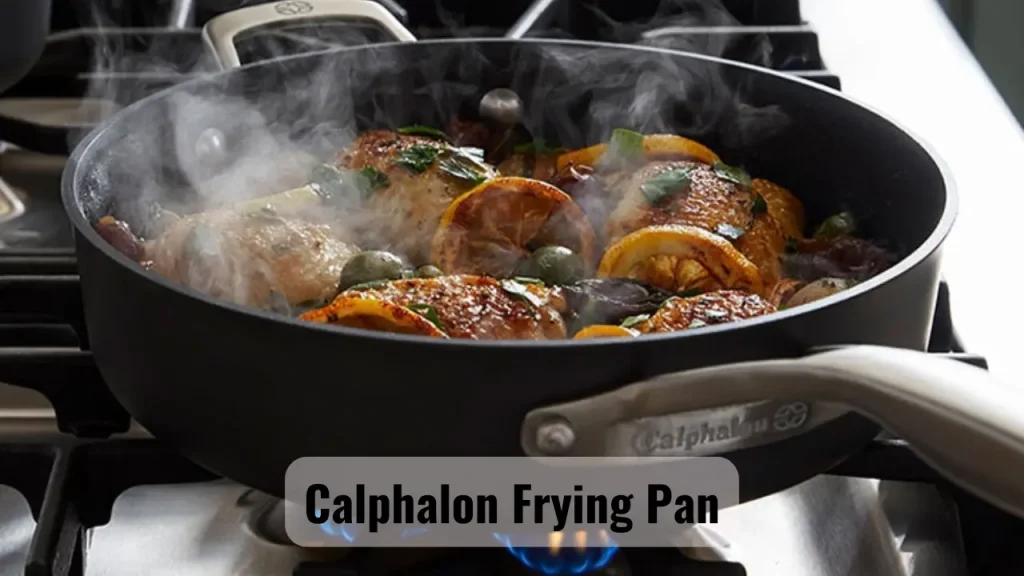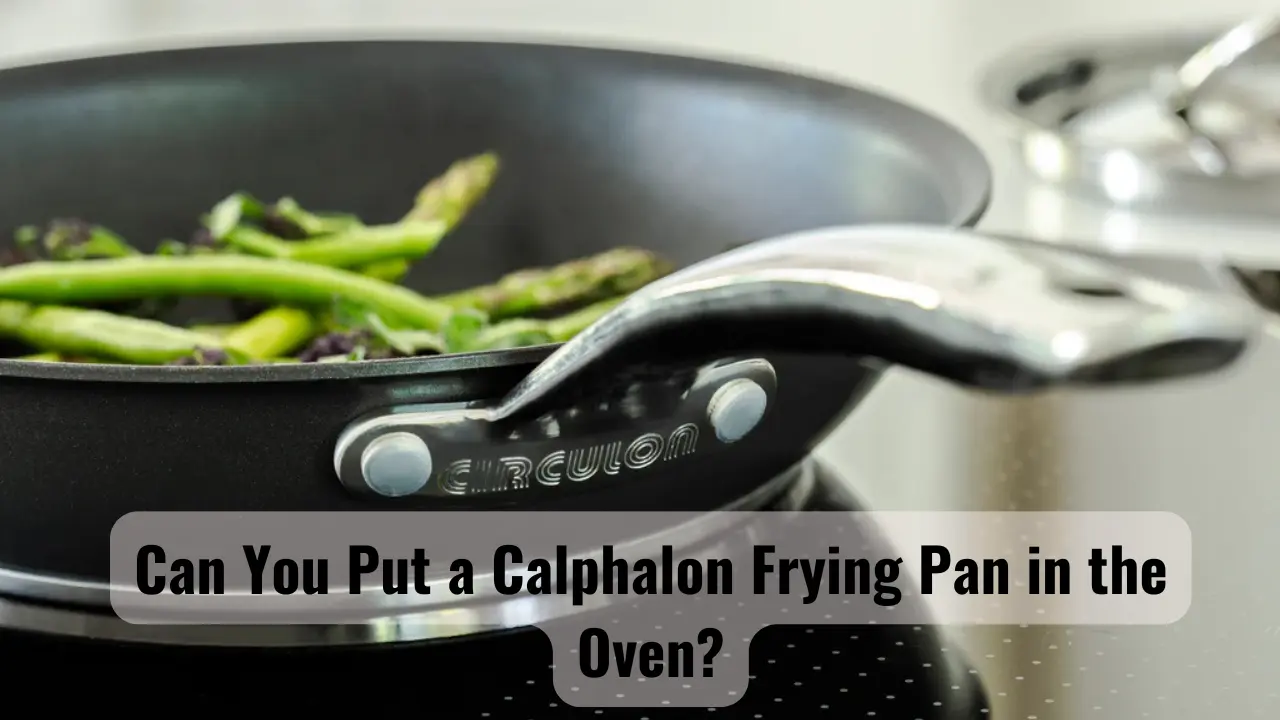Yes, you can put a Calphalon frying pan in the oven. But, there are some important details to keep in mind.
Calphalon frying pans are popular for their durability and performance. They often come with features that make them versatile for various cooking methods. One common question is whether these pans are oven-safe. Understanding the specifics of oven safety can help you make the most out of your Calphalon pan.
This blog post will explore the key points you need to know. From temperature limits to handle materials, we will cover all the essential information. This way, you can use your Calphalon frying pan safely and effectively in the oven.
Introduction To Calphalon Frying Pans

Calphalon frying pans are a popular choice in many kitchens. They are known for their durability and excellent cooking performance. These pans are versatile and can be used for various cooking methods. But can you put a Calphalon frying pan in the oven? Let’s explore this further.
What Makes Calphalon Unique
Calphalon frying pans are made from high-quality materials. They often feature non-stick surfaces, making cooking and cleaning easier. The brand uses hard-anodized aluminum for many of its products. This material heats evenly and resists corrosion.
Calphalon also offers pans with stainless steel construction. These provide excellent heat retention. The design often includes stay-cool handles. This feature adds safety and comfort while cooking.
Common Uses Of Calphalon Frying Pans
Calphalon frying pans are ideal for many cooking tasks. You can use them to sauté vegetables or sear meats. They are also perfect for making omelets and pancakes.
These pans are suitable for stir-frying and browning food. Many people use Calphalon pans for making sauces or simmering liquids. The non-stick surface ensures food does not stick, enhancing the cooking experience.
With their durable construction, Calphalon pans can handle high heat. This makes them suitable for oven use, depending on the model. Always check the manufacturer’s guidelines before placing a pan in the oven.
Oven-safe Features Of Calphalon Pans
Calphalon frying pans can go in the oven. Their handles and lids are made to withstand high heat. This makes them perfect for cooking dishes that start on the stove and finish in the oven.
Hey friends, today let’s talk about Calphalon pans. Ever wondered if you could put your Calphalon frying pan in the oven? The good news? You can! In this section, we will explore the oven-safe features of Calphalon pans. We will cover their material composition and heat resistance. Ready? Let’s dive in.
Material Composition
Calphalon pans are made from high-quality materials. These materials make them oven-safe. Here’s what you need to know:
- Hard-Anodized Aluminum: This is a common material in Calphalon pans. It is strong and resists damage. It’s like armor for your pan!
- Stainless Steel: Another popular choice. It looks shiny and fancy. Plus, it can handle high heat. Think of it like the superhero of metals.
- Non-Stick Coating: Many Calphalon pans have a non-stick surface. This makes cooking and cleaning easy. Just remember, not all non-stick pans are oven-safe. Check the label first.
I recently asked my friend about her experience with Calphalon pans. She loves how durable they are. “I’ve had my Calphalon pan for years, and it still looks new!” she said.
Heat Resistance
Now let’s talk about heat resistance. This is super important for oven use.
- Temperature Limits: Calphalon pans can usually handle up to 500°F. Always check your pan’s manual to be sure. You don’t want any surprises.
- Handle Material: Some handles are made of stainless steel or silicone. These materials are oven-safe. But, if the handle is plastic, it might melt. Be careful!
- Lid Safety: If your pan has a lid, check if it’s oven-safe too. Glass lids can shatter if they get too hot. Better safe than sorry!
Imagine cooking a delicious steak on your stove. You want to finish it in the oven for that perfect crust. With a Calphalon pan, you can do just that. It’s like having a restaurant-quality tool at home.
In summary, knowing the oven-safe features of Calphalon pans can make your cooking easier and safer. Always check the material and heat limits. This way, your pan will serve you well for many future meals.
So next time you cook, feel confident using your Calphalon pan in the oven. Happy cooking!
Benefits Of Using Calphalon Pans In The Oven
Hey friends, today we are talking about using Calphalon frying pans in the oven. Why? Because they offer some amazing benefits that can help you cook better and easier. Whether you are making a simple dish or trying something fancy, these pans can be a great addition to your kitchen. Let’s dive into the benefits!
Versatility In Cooking
One of the best things about Calphalon pans is their versatility. You can use them on the stove, and then pop them straight into the oven. No need to switch pans. This is super helpful when you are trying to sear meat and then finish cooking it in the oven. Or when you want to bake something that starts on the stovetop. It’s like having two tools in one!
Imagine making a delicious frittata. You start by cooking the veggies on the stove. Then, you add the eggs and cheese. Instead of transferring to a baking dish, just place the whole pan in the oven. Easy peasy!
Enhanced Flavor And Texture
Cooking with Calphalon pans can also improve the flavor and texture of your food. How? By allowing even heating and browning. This means your food cooks more evenly, avoiding those burnt spots or undercooked areas. The result? Better taste and texture.
Take roasted vegetables for example. When you roast veggies in a Calphalon pan, they get that perfect golden-brown color. Crispy on the outside, tender on the inside. Yum! Plus, the nonstick surface means you can use less oil, making your meals healthier.
Another benefit? Less cleanup. Because the pan goes from stovetop to oven, you have fewer dishes to wash. And who doesn’t love that?
Potential Risks And Concerns
Cooking enthusiasts often ask if they can put a Calphalon frying pan in the oven. While it is possible, there are potential risks and concerns to consider. Knowing these can help you avoid damaging your cookware and ensure safety in the kitchen.
High Temperature Damage
Calphalon frying pans can withstand oven temperatures up to a certain limit. Exceeding this limit can damage the non-stick coating. The coating can start to peel or degrade. This reduces the pan’s effectiveness and lifespan. Always check the manufacturer’s guidelines for the maximum oven-safe temperature.
Handle Safety
The handles of Calphalon frying pans are often made of different materials. Some handles can withstand high heat, while others cannot. Metal handles are generally safe up to the pan’s maximum temperature limit. Plastic or rubber handles may melt or become damaged. Always ensure the handle material is oven-safe before placing the pan in the oven.
Proper Techniques For Oven Use
Hey there, cooking enthusiasts! So, you’ve got a Calphalon frying pan and you’re wondering if it can go in the oven. The good news? It can! But, there are a few things you should know to do it right. Let’s dive into the proper techniques for using your Calphalon pan in the oven.
Preheating The Pan
First things first, preheating your pan is key. Why? It helps ensure even cooking. Here’s how you can do it:
- Place the pan in the oven while it’s cold.
- Turn on the oven to your desired temperature.
- Let the pan heat up as the oven preheats.
Simple, right? Just like preheating your oven before baking a cake, preheating your pan can make a big difference. Trust me, you don’t want to skip this step.
Temperature Guidelines
When it comes to temperature, safety is a must. Calphalon pans are oven-safe, but only up to a certain point. Here are some guidelines to follow:
| Pan Material | Maximum Oven Temperature |
|---|---|
| Nonstick | 450°F (232°C) |
| Stainless Steel | 500°F (260°C) |
| Hard-Anodized | 500°F (260°C) |
Always check the manufacturer’s guidelines for your specific pan. Going over the recommended temperature can damage the pan and ruin your meal.
Now, let me share a quick story. I once decided to cook a frittata using my Calphalon pan. I preheated the oven but forgot to check the temperature guidelines. The result? A warped pan and a burnt frittata. Lesson learned!
So, remember:
- Preheat your pan.
- Follow the temperature guidelines.
Using your Calphalon pan in the oven can be a game-changer for your cooking. Just follow these steps, and you’ll be on your way to delicious, evenly cooked meals. Happy cooking!

Credit: www.amazon.com
Maintaining Your Calphalon Frying Pan
Maintaining your Calphalon frying pan ensures it lasts a long time. It also guarantees your cooking experience remains enjoyable. This section provides useful tips for keeping your pan in top shape.
Cleaning Tips
Wash your Calphalon frying pan by hand. Use warm water and mild dish soap. Avoid abrasive sponges or steel wool. These can scratch the surface. Instead, use a soft sponge or cloth. Dry the pan thoroughly with a towel after washing.
If food sticks to the pan, don’t worry. Soak it in warm, soapy water for about 15 minutes. This helps loosen the residue. Then, use a non-abrasive sponge to clean it.
Long-term Care
Store your Calphalon frying pan properly. Avoid stacking it with other cookware. This prevents scratches. If you must stack, place a soft cloth between pans.
Keep the non-stick surface intact. Avoid using metal utensils. Opt for wooden or silicone utensils instead. This helps maintain the pan’s coating.
Regularly check the pan’s condition. If you notice any damage or wear, consider replacing it. A well-maintained pan ensures better cooking results. Follow these tips to keep your Calphalon frying pan in excellent condition.
Common Mistakes To Avoid
Using a Calphalon frying pan in the oven can be very handy. But, there are common mistakes that many people make. These mistakes can damage your pan or affect your cooking.
Using Metal Utensils
Metal utensils can scratch the surface of your Calphalon pan. These scratches can make the non-stick coating less effective. Always use wooden or silicone utensils. They are gentle on the pan’s surface.
Rapid Temperature Changes
Placing a hot pan under cold water can cause warping. The sudden change in temperature can damage the pan. Let the pan cool naturally before washing it. This keeps the pan in good shape for a long time.

Credit: prudentreviews.com
Frequently Asked Questions
How Do I Know If My Calphalon Pan Is Oven Safe?
Check the bottom of the pan or its packaging. Look for an oven-safe symbol or temperature range.
How Do I Know If My Frying Pan Is Oven Safe?
Check the bottom of the pan or its packaging for oven-safe symbols. Consult the manufacturer’s guidelines.
When Should I Throw Away My Calphalon Pans?
Throw away Calphalon pans when the non-stick coating is scratched, peeling, or food starts sticking. Replace if warping occurs.
Can You Put A Pan In The Oven With A Rubber Handle?
No, do not put a pan with a rubber handle in the oven. Rubber can melt or get damaged.
Conclusion
Understanding if your Calphalon frying pan is oven-safe is crucial. Always check the manufacturer’s guidelines. Most Calphalon pans can handle oven heat. Be mindful of the handle material. Silicone handles can usually withstand oven temperatures. Stainless steel handles are typically safe too.
Regular care extends the life of your cookware. Enjoy versatile cooking with your oven-safe Calphalon frying pan. Happy cooking!

